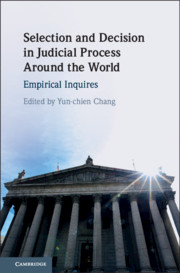Book contents
- Selection and Decision in Judicial Process around the World
- Selection and Decision in Judicial Process around the World
- Copyright page
- Dedication
- Contents
- List of Figures
- List of Tables
- List of Contributors
- Acknowledgments
- Introduction
- 1 Do Patent Law Suits Target Invalid Patents?
- 2 Platform Procedure
- 3 Speedy Adjudication in Hard Cases and Low Settlement Rates in Easy Cases
- 4 How Lower Courts Respond to a Change in a Legal Rule
- 5 Career Judge System and Court Decision Biases
- 6 Judges Avoid Ex Post but Not Ex Ante Inefficiency
- 7 When Winning Is Not Enough
- 8 The Evolution of Case Influence in Modern Consumer Standard Form Contracts
- 9 Judging Insurance Antidiscrimination Law
- 10 Are Judges Harsher with Repeat Offenders?
- 11 Does Efficiency Trump Legality?
- Index
- References
8 - The Evolution of Case Influence in Modern Consumer Standard Form Contracts
Published online by Cambridge University Press: 04 December 2019
- Selection and Decision in Judicial Process around the World
- Selection and Decision in Judicial Process around the World
- Copyright page
- Dedication
- Contents
- List of Figures
- List of Tables
- List of Contributors
- Acknowledgments
- Introduction
- 1 Do Patent Law Suits Target Invalid Patents?
- 2 Platform Procedure
- 3 Speedy Adjudication in Hard Cases and Low Settlement Rates in Easy Cases
- 4 How Lower Courts Respond to a Change in a Legal Rule
- 5 Career Judge System and Court Decision Biases
- 6 Judges Avoid Ex Post but Not Ex Ante Inefficiency
- 7 When Winning Is Not Enough
- 8 The Evolution of Case Influence in Modern Consumer Standard Form Contracts
- 9 Judging Insurance Antidiscrimination Law
- 10 Are Judges Harsher with Repeat Offenders?
- 11 Does Efficiency Trump Legality?
- Index
- References
Summary
This chapter explores the evolution of judicial influence using a hand-collected data set of all cases until 2016 that address the enforceability of clickwrap, shrinkwrap, and browsewrap contracts as well as their out-of-state influence over time. A foundational theory conceptualizes precedent as an investment that yields valuable information to subsequent courts that depreciates over time, as new circumstances and innovations make such precedent less helpful for later courts. Empirical research on judicial citations has found a “superstar” or “tournament winner” effect, whereby a handful of cases garner almost all citations for a given question. How do tournament winners fare over time? I find that the citation universe is indeed dominated by “tournament winners.” These cases, which tend to be decided by circuit court judges, influence other courts from the date they are decided. Instead of experiencing depreciation, however, I find that their influence continues to grow, even over cases that are hierarchically more important. In addition, cases tend to converge towards a particular rule or standard over time. The results enrich our understanding of the evolution of judicial influence and help inform theories of the evolution of precedent and the common law.
- Type
- Chapter
- Information
- Selection and Decision in Judicial Process around the WorldEmpirical Inquires, pp. 204 - 222Publisher: Cambridge University PressPrint publication year: 2019

